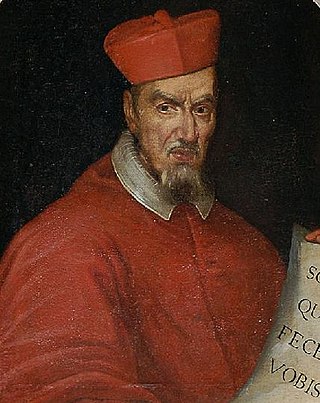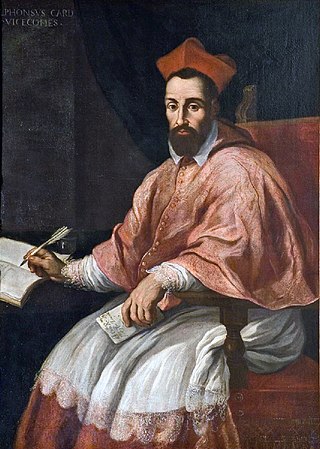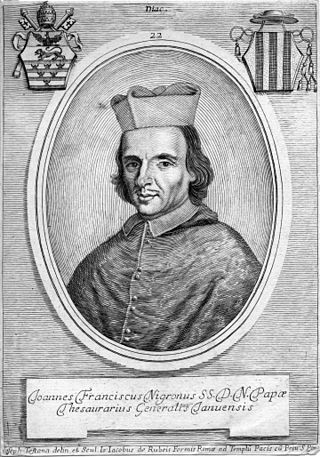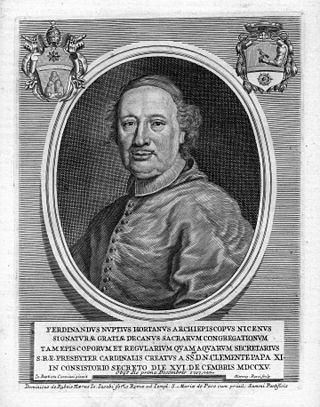
Pope Urban VII, born Giovanni Battista Castagna, was head of the Catholic Church, and ruler of the Papal States from 15 to 27 September 1590. His papacy was the shortest in history, during which a smoking ban encompassing churches across the world was implemented.

The Camerlengo of the Holy Roman Church is an office of the papal household that administers the property and revenues of the Holy See. Formerly, his responsibilities included the fiscal administration of the Patrimony of Saint Peter. As regulated in the apostolic constitution Pastor bonus of 1988, the Camerlengo is always a cardinal, though this was not the case prior to the 15th century. His heraldic arms are ornamented with two keys – one gold, one silver – in saltire, surmounted by an ombrellino, a canopy or umbrella of alternating red and yellow stripes. These also form part of the coat of arms of the Holy See during a papal interregnum. The Camerlengo has been Kevin Farrell since his appointment by Pope Francis on 14 February 2019. The Vice Camerlengo has been Archbishop Ilson de Jesus Montanari since 1 May 2020.
The papal majordomo or chief steward of the household of the pope is one of the three palatine prelates, concerning whom particulars have been given in the article maestro di camera.

Girolamo Grimaldi-Cavalleroni was an Italian cardinal of the Roman Catholic Church and Archbishop of Aix.

Alfonso Michele Litta was an Italian nobleman who was a Cardinal and Archbishop of Milan from 1652 to 1679.

Alderano Cybo was an Italian Catholic Cardinal. He served as the Secretary of State of Pope Innocent XI.

Francesco Gonzaga was an Italian bishop and a Cardinal of the Roman Catholic Church during the reigns of Popes Pius II, Paul II and Sixtus IV.

Giovanni Stefano Donghi was an Italian Catholic cardinal.

Stefano Durazzo was an Italian Catholic cardinal and archbishop of Genoa.

Pietro Marini was a Catholic cardinal.

Giovanni BattistaCicala (1510–1570) was an Italian Roman Catholic bishop and cardinal.
Lorenzo Raggi was an Italian Catholic Cardinal.

Giovanni Francesco Guidi di Bagno (1578–1641) was an Italian cardinal, brother of cardinal Nicola Guidi di Bagno and nephew of cardinal Girolamo Colonna.
The Diocese of Mariana in Corsica was a Roman Catholic ecclesiastical territory in Mariana, Corsica, in the north-eastern corner of the island. In 1563 the diocese was united with the Diocese of Acci(a) to form the Diocese of Accia and Mariana. Both dioceses were poor and had lost population. Mariana had been abandoned and its bishop lived in Bastia to the north, the seat of the civil government of the island. The Cathedral sat alone near the banks of the River Golo some three miles from the sea, in the midst of fields.
The Diocese of Aleria was a Roman Catholic diocese of the Latin rite, in the center of the eastern coast of the island of Corsica in the Department of Haute-Corse. The town of Aleria was subject to repeated raids by Arab fleets in the eighth and ninth centuries, and eventually abandoned, many of its people fleeing to the mainland. The bishop moved to a secure stronghold to the north. From at least the eleventh century, the diocese was a suffragan of the metropolitan archdiocese of Pisa. The diocese was suppressed by the Civil Constitution of the Clergy in 1790, and was not revived after the Concordat of 1801 between the French Consulate and the Papacy. It has been a titular diocese since 2002.

Marcantonio Bragadin was a Venetian Catholic cardinal who served as Bishop of Vicenza.

Alfonso Visconti (1552–1608) was an Italian Roman Catholic cardinal and diplomat.

Giovanni Francesco Negroni was a Catholic cardinal who served as Bishop of Faenza from 1687 to 1697, and as Legate of Bologna from 1687 to 1690.

Ferdinando Nuzzi was a Catholic cardinal who served as officer of the Papal States and as Bishop of Orvieto from 1716 to his death.
Ludovico Taverna was an Italian diplomat and bishop, who served as Apostolic Nuncio to Spain from 1582 to 1585, as Apostolic Nuncio to Venice from 1592 to 1596 and as Bishop of Lodi from 1579 to 1616.














